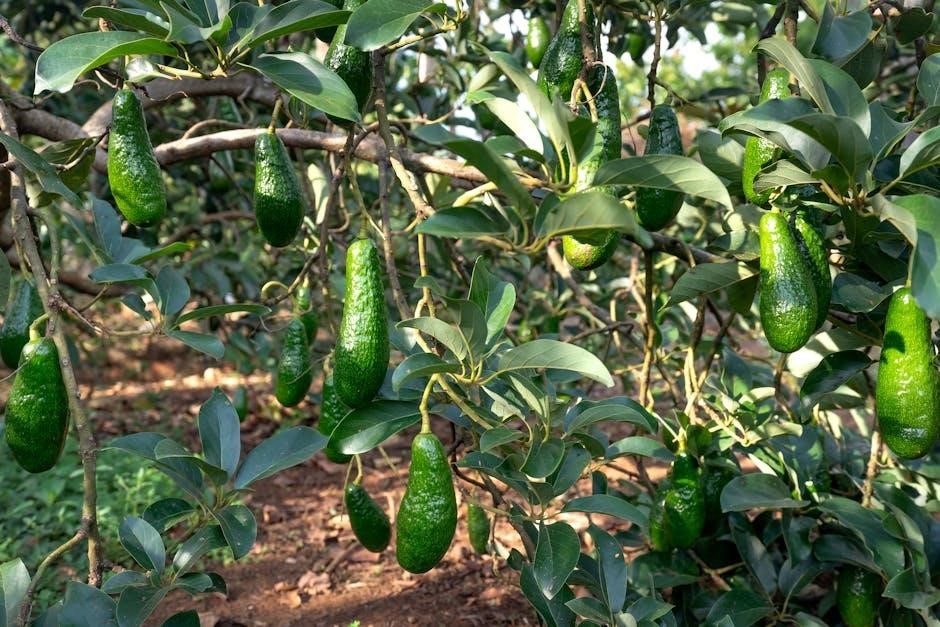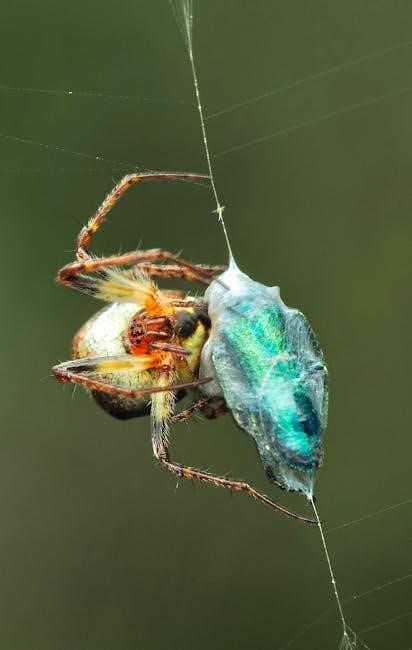A food web is a network of interconnected food chains, illustrating how energy flows through an ecosystem. It includes producers, consumers, and decomposers, showing ecosystem dynamics and energy transfer.
Definition and Basic Concepts
A food web is a visual representation of the feeding relationships within an ecosystem, showcasing how energy and nutrients flow between organisms. Unlike a food chain, which is a linear sequence, a food web is a complex network of multiple food chains interconnected. It illustrates the diverse pathways through which energy is transferred from producers to various levels of consumers and ultimately to decomposers. Producers, such as plants, form the base of the food web, converting sunlight into energy through photosynthesis. Consumers, ranging from herbivores to carnivores, rely on producers or other animals for energy. Decomposers, like fungi and bacteria, break down dead organisms, recycling nutrients back into the ecosystem. Understanding these interactions is fundamental for analyzing ecosystem balance and the roles organisms play in sustaining life.
The Role of Producers, Consumers, and Decomposers
Producers, primarily plants and algae, are the foundation of a food web. They convert sunlight into energy through photosynthesis, providing sustenance for other organisms. Consumers, such as herbivores and carnivores, rely on producers or other animals for energy, forming multiple trophic levels. Decomposers, like bacteria and fungi, break down dead organisms, recycling essential nutrients back into the ecosystem. This cycle ensures that nutrients are replenished, supporting the growth of producers and maintaining the food web’s balance. Each role is vital for the survival of the ecosystem, as they collectively sustain the flow of energy and nutrients, promoting biodiversity and ecological stability. Understanding these roles is crucial for analyzing how ecosystems function and how disruptions can impact the entire food web.
Importance of Food Web Worksheets
Food web worksheets are essential for understanding ecosystem dynamics, offering educational tools that enhance student engagement and curriculum development in biology and environmental studies.
Educational Benefits for Students
Food web worksheets provide students with interactive tools to explore ecosystem dynamics, fostering critical thinking and visual learning. By identifying producers, consumers, and decomposers, students gain a deeper understanding of energy flow and trophic levels. These worksheets also enhance problem-solving skills through activities like constructing food chains and analyzing nutrient cycling. Additionally, they offer a structured format for assessing comprehension of complex ecological concepts, making them invaluable for curriculum development. The hands-on approach encourages engagement and retention, preparing students for advanced topics like symbiotic relationships and ecosystem balance. Overall, food web worksheets are essential for building a strong foundation in biology and environmental science.
Practical Applications in Curriculum Development
Food web worksheets serve as versatile tools for curriculum development, aligning with educational standards and enhancing lesson plans. Educators can incorporate these worksheets to teach trophic levels, energy flow, and ecosystem interactions. They provide structured activities that cater to different learning styles, ensuring comprehensive understanding. Worksheets also enable formative assessments, allowing teachers to track student progress and identify knowledge gaps. By integrating food web diagrams and questions, teachers can create engaging units that promote hands-on learning. Additionally, these resources facilitate differentiated instruction, accommodating varied student needs and abilities; Overall, food web worksheets offer practical solutions for educators seeking to enrich their biology and environmental science curricula with interactive and effective learning materials.

Key Components of a Food Web Worksheet
A food web worksheet includes producers, primary consumers, secondary consumers, tertiary consumers, and decomposers, illustrating energy flow through an ecosystem.
Producers in a Food Web
Producers are organisms that form the base of a food web, primarily plants, algae, and some bacteria. They produce their own food through photosynthesis or chemosynthesis, converting sunlight or chemical energy into organic matter. These organisms are vital as they provide the energy and nutrients for all other life forms in the ecosystem. In a food web worksheet, producers are often highlighted as the starting point, illustrating how energy flows from them to herbivores and beyond. Identifying producers is a fundamental skill, as they are essential for sustaining life and maintaining ecological balance. Without producers, other organisms would not have the necessary energy to survive, making them the cornerstone of any food web.
Primary, Secondary, and Tertiary Consumers
Primary consumers are herbivores that directly feed on producers, such as grasshoppers eating grass or deer consuming leaves. They represent the second trophic level in a food web. Secondary consumers are carnivores that eat primary consumers, like frogs eating insects or small mammals. Tertiary consumers are apex predators, such as hawks or wolves, that prey on secondary consumers, occupying the highest trophic level. These levels illustrate the flow of energy through an ecosystem, with each consumer relying on the previous level for sustenance. worksheets often emphasize identifying these categories to understand ecosystem dynamics. Producers and consumers together form the foundation of food webs, showcasing the interconnectedness of species and their roles in energy transfer. This hierarchy is crucial for maintaining ecological balance and ensuring the survival of diverse species.
Decomposers and Their Role
Decomposers, such as bacteria, fungi, and certain insects, play a vital role in food webs by breaking down dead organic matter into simpler nutrients. These organisms recycle energy and nutrients, returning them to the environment for producers to reuse. Decomposers are essential for maintaining ecosystem balance, as they prevent dead material from accumulating and release nutrients back into the soil. This process ensures that energy and resources are continuously cycled through the food web, supporting the growth of producers and, in turn, all other organisms. Worksheets often highlight decomposers to emphasize their importance in nutrient cycling and energy flow. Without decomposers, ecosystems would stagnate, and the flow of energy through trophic levels would be disrupted. Their role is crucial for sustaining life and maintaining the health of ecosystems.

Answer Key Structure
An answer key structure provides correct responses to food web worksheet questions, ensuring clarity and accuracy. It includes explanations for identifying trophic levels, food chains, and ecosystem interactions.
Understanding Trophic Levels
Trophic levels are the feeding positions in a food web, starting with producers at the base. These levels categorize organisms based on their dietary roles. Producers, like plants, form the first trophic level as they create their own food through photosynthesis. Herbivores, such as deer and insects, occupy the second level as primary consumers. Carnivores, like birds and frogs, make up the third level as secondary consumers, while apex predators, such as lions and hawks, are tertiary consumers. Decomposers, though not part of the trophic levels, break down organic matter, recycling nutrients. Understanding these levels helps in mapping energy flow and nutrient cycling within ecosystems, essential for grasping food web dynamics and ecological balance.
Interpreting Food Chains Within a Food Web
A food chain is a linear pathway showing the flow of energy from one organism to another within a food web. It begins with producers and progresses through herbivores and carnivores. For example, in a grassland ecosystem, a food chain might be: Grass → Rabbit → Hawk. Each organism represents a trophic level, with energy decreasing at each step. Worksheets often include multiple food chains interconnected to form a food web. To interpret these, identify the starting producer, trace the flow of energy, and recognize the highest consumer. Decomposers, though not part of the chain, are crucial for nutrient recycling. Analyzing food chains helps students understand predator-prey relationships, energy transfer efficiency, and ecosystem balance, making them a fundamental tool in ecology education.

Common Questions and Answers
Q: What is a food web?
A: A food web is a network of food chains showing energy flow between organisms in an ecosystem.
Q: What distinguishes food chains from food webs?
A: Food chains are linear pathways, while food webs are interconnected, showing multiple energy pathways.
Q: Who are the key organisms in a food web?
A: Producers, consumers, and decomposers form the core of a food web, facilitating energy and nutrient cycling.
What is a Food Web?
A food web is a complex network of food chains that illustrates the various pathways through which energy and nutrients flow within an ecosystem. It shows how different organisms, such as producers, consumers, and decomposers, are interconnected. Unlike a food chain, which is a linear sequence of feeding relationships, a food web provides a more comprehensive view of energy transfer, highlighting multiple possible pathways for energy to flow from one organism to another. This interconnected structure allows ecosystems to maintain stability and adapt to changes. Food webs are essential for understanding biodiversity, predator-prey relationships, and the overall balance of nature. They are widely used in educational resources, such as worksheets, to help students visualize and analyze ecological interactions. By studying food webs, one can gain insights into the intricate dynamics of ecosystems and the roles of different organisms within them.
Distinguishing Food Chains vs. Food Webs
Food chains and food webs are fundamental concepts in ecology, but they differ in complexity and scope. A food chain is a linear sequence showing the flow of energy from one organism to another, such as grass → rabbit → fox. In contrast, a food web is a network of multiple interconnected food chains, representing various feeding relationships within an ecosystem. While a food chain provides a simple, direct pathway of energy transfer, a food web offers a broader view, demonstrating how different species can be part of multiple energy pathways. This distinction is crucial for understanding ecosystem dynamics, as food webs highlight the interconnectedness and resilience of ecosystems. Worksheets often include exercises to help students differentiate between these two concepts, emphasizing their unique roles in ecological studies.
Identifying Key Organisms in a Food Web
Identifying key organisms in a food web involves recognizing producers, consumers, and decomposers. Producers, such as plants and algae, form the base of the food web, converting sunlight into energy. Primary consumers, like herbivores, feed on producers, while secondary consumers, such as carnivores, eat primary consumers. Tertiary consumers, at the top of the food chain, prey on secondary consumers. Decomposers, like bacteria and fungi, break down dead organisms, recycling nutrients. Worksheets often include exercises where students label and categorize these organisms within a food web diagram. This helps in understanding the flow of energy and the interconnectedness of species. For example, in a grassland food web, grass is a producer, a rabbit is a primary consumer, a fox is a secondary consumer, and a hawk is a tertiary consumer. Such exercises enhance students’ ability to analyze and interpret ecosystem dynamics effectively.

Advanced Topics in Food Webs
Advanced topics in food webs explore complex interactions, including symbiotic relationships and energy flow dynamics. These concepts highlight how organisms interact beyond basic predator-prey dynamics, shaping ecosystem balance.
Symbiotic Relationships
Symbiotic relationships are crucial in food webs, involving interactions like mutualism, commensalism, and parasitism. Mutualism benefits both species, such as clownfish and sea anemones. Commensalism aids one without harming the other, like remora fish cleaning sharks. Parasitism harms one, as with tapeworms in hosts. These relationships influence energy flow and ecosystem stability, often appearing in food web worksheets to enhance understanding of complex interactions beyond basic predator-prey dynamics. By studying these, students grasp how species dependencies shape food web structures and biodiversity. Worksheets may include identifying mutualistic pairs or analyzing how parasites affect energy transfer. Such exercises deepen comprehension of ecological balance and interdependence.
Energy Flow and Nutrient Cycling
Energy flow in food webs is unidirectional, moving from producers to consumers, with only 10% of energy transferred between trophic levels. This inefficiency explains the pyramid structure of ecosystems. Nutrient cycling ensures the reuse of essential elements like carbon, nitrogen, and phosphorus. Decomposers break down organic matter, returning nutrients to the soil for producers to absorb, sustaining life. Food web worksheets often include diagrams of energy pyramids and nutrient cycles, helping students visualize these processes. Questions may ask students to identify trophic levels or trace nutrient pathways. Understanding energy flow and nutrient cycling is critical for grasping ecosystem balance and sustainability. Worksheets make these abstract concepts interactive and easier to comprehend for learners. They also highlight the interconnectedness of species and the environment, fostering ecological awareness.

Creating Effective Worksheets
Effective worksheets engage students with clear questions and visual aids, ensuring comprehension. Incorporate diagrams, food web examples, and an answer key for assessment. Clarity and relevance enhance learning outcomes.
Designing Clear and Concise Questions
When creating food web worksheets, it’s crucial to design questions that are straightforward and unambiguous. This ensures students can focus on understanding the material without confusion. Questions should target specific concepts, such as identifying producers, herbivores, carnivores, and decomposers; Additionally, incorporating multiple-choice, true/false, and fill-in-the-blank formats can cater to different learning styles. Open-ended questions encourage critical thinking, allowing students to explain trophic levels or energy flow. Aligning questions with curriculum standards ensures relevance and effectiveness. Providing an answer key helps teachers assess student progress and identify areas needing further instruction. Clear instructions and examples within the worksheet also guide students, making the learning process more efficient and engaging. By structuring questions thoughtfully, educators can enhance comprehension and retention of food web concepts.

Incorporating Visual Aids and Diagrams
Visual aids and diagrams are essential for making food web concepts engaging and accessible. Including detailed food web diagrams helps students visualize energy flow and trophic levels. Color-coded illustrations can differentiate producers, herbivores, carnivores, and decomposers, enhancing clarity. Flowcharts or infographics can break down complex relationships into digestible parts. Adding images of organisms, such as grass, wildflowers, rabbits, and hawks, makes the content relatable. Diagrams like energy pyramids can show how energy decreases at higher trophic levels. Interactive elements, such as fillable food chains or webs, encourage hands-on learning. Visual aids also cater to diverse learning styles, benefiting visual and kinesthetic learners. By integrating these tools, educators create a dynamic and effective learning environment that complements written content and reinforces key concepts in food web worksheets.

Case Studies and Examples
Case studies explore food webs in specific ecosystems, like forests or coral reefs, showcasing interactions between organisms. Examples include grass, wildflowers, rabbits, and hawks, illustrating energy flow and biodiversity.
Terrestrial Ecosystem Food Webs

Terrestrial food webs represent energy flow in land-based ecosystems, involving plants, herbivores, carnivores, and decomposers. Producers like grass and wildflowers form the base, converting sunlight into energy. Herbivores such as rabbits and deer consume these plants, while predators like hawks and wolves feed on herbivores. Decomposers, including bacteria and fungi, break down dead organisms, recycling nutrients. These interactions highlight biodiversity and nutrient cycling. For example, in a forest food web, grass supports rabbits, which in turn feed foxes. Hawks, as apex predators, regulate populations. Energy flows through trophic levels, with each organism playing a vital role. Worksheets often use such examples to teach students about ecosystem balance and the interconnectedness of species. Understanding these dynamics helps in grasping ecological principles and conservation strategies.
Aquatic Ecosystem Food Webs
Aquatic food webs depict energy flow in water-based ecosystems, such as oceans, lakes, and rivers. Producers like phytoplankton and algae form the base, converting sunlight into energy through photosynthesis. Zooplankton and small fish serve as primary consumers, feeding on phytoplankton. Secondary consumers, such as larger fish, feed on these smaller organisms. Tertiary consumers, like sharks or dolphins, represent apex predators. Decomposers, including bacteria and fungi, break down dead organisms, recycling nutrients back into the system. Aquatic food webs are crucial for maintaining ecosystem balance and supporting marine life. Worksheets often use coral reefs or pond ecosystems as examples, helping students visualize how energy flows through aquatic environments. These tools emphasize the interconnectedness of species and the importance of conservation in preserving aquatic biodiversity.
Food web worksheets are invaluable educational tools, enhancing understanding of ecosystem dynamics and energy flow. They promote critical thinking and practical application, fostering a deeper appreciation for biodiversity and conservation.
The Importance of Food Web Worksheets in Education

Food web worksheets are essential tools in education, helping students grasp complex ecological concepts. They simplify the understanding of energy flow, trophic levels, and relationships between organisms. By engaging students in hands-on activities, these worksheets enhance critical thinking and problem-solving skills. They also promote visual learning through diagrams and food chain exercises, making abstract ideas more tangible. Additionally, worksheets encourage students to analyze real-world ecosystems, fostering an appreciation for biodiversity and conservation. The inclusion of answer keys provides clear feedback, ensuring students can assess their progress and understanding. Overall, food web worksheets are versatile resources that align with educational standards, making them invaluable for both teachers and learners in science curricula.
Future Directions in Food Web Studies
Future research in food web studies will focus on understanding the impacts of climate change and invasive species on ecosystem dynamics. Advances in technology, such as computational modeling and network analysis, will enable more detailed examinations of complex interactions. Integrating food web theory with conservation biology will help develop strategies to protect vulnerable species and maintain biodiversity. Additionally, incorporating food web concepts into educational curricula will enhance students’ understanding of ecological principles. The development of interactive and digital tools, such as dynamic food web simulations, will make learning more engaging and accessible. These advancements will not only deepen our knowledge of ecosystems but also inform sustainable practices for environmental management and policy-making in the face of global challenges.
